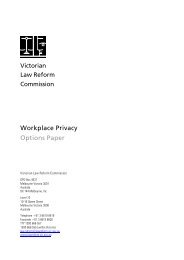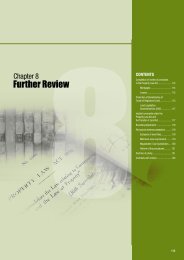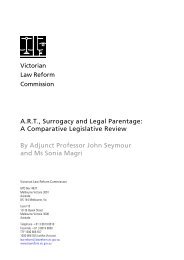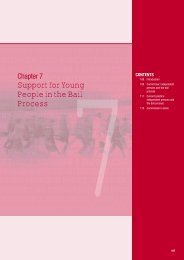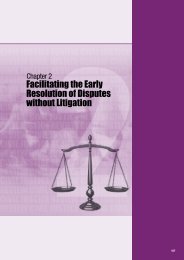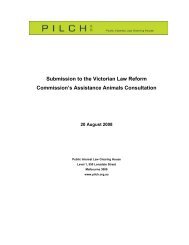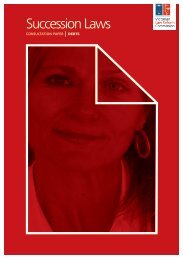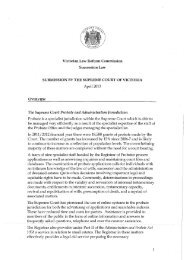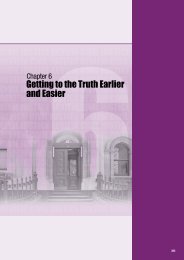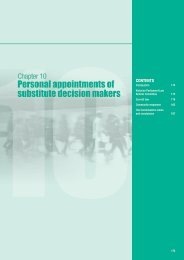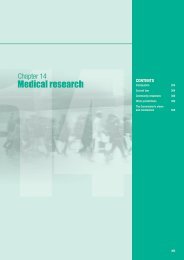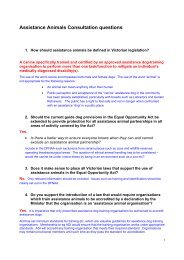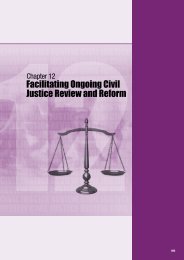Crimes Mental Impairment consultation paper.pdf - Victorian Law ...
Crimes Mental Impairment consultation paper.pdf - Victorian Law ...
Crimes Mental Impairment consultation paper.pdf - Victorian Law ...
Create successful ePaper yourself
Turn your PDF publications into a flip-book with our unique Google optimized e-Paper software.
4<br />
Directions to the jury on findings in special hearings<br />
4.132 At the commencement of a special hearing, the judge must explain to the jury:<br />
• that the accused person is unfit to stand trial<br />
• the meaning of being unfit to stand trial<br />
• the purpose of a special hearing<br />
• the findings that are available<br />
• the standard of proof required for those findings. 160<br />
4.133 As discussed earlier, section 17(1) of the CMIA provides that the following findings are<br />
available to the jury at a special hearing: not guilty, not guilty of the offence because of mental<br />
impairment and committed the offence charged. Recently, there has been some confusion<br />
on the extent of the trial judge’s obligation to direct the jury on the findings available in<br />
special hearings, particularly whether the judge must explain all three possible findings.<br />
4.134 In R v Langley (Langley), 161 the trial judge only explained two findings to the jury that<br />
were open on the evidence. The trial judge did not tell the jury that they could find the<br />
defendant not guilty because of mental impairment. The Court of Appeal held that the<br />
trial judge should have explained all three findings to the jury. It said that whether or not<br />
the defendant was suffering from a mental impairment was clearly a question of fact<br />
for the jury to determine. 162 This was despite the fact that at the special hearing there<br />
had been no positive or direct evidence that the defendant had a mental impairment at<br />
the time of the offence. It means that even where there is no evidence in relation to the<br />
finding, or when the defendant wishes that the finding not be left to the jury, all findings<br />
must still be put to the jury. 163<br />
4.135 The approach taken in Langley is potentially inconsistent with the approach taken by the<br />
High Court when considering a very similar issue. In Subramaniam v The Queen, 164 the<br />
High Court considered section 21(4) of the <strong>Mental</strong> Health (Criminal Procedure) Act 1990<br />
(NSW) that sets out what the trial judge should explain to the jury, including ‘the verdicts<br />
which are available’. The High Court stated that the trial judge must direct the jury on the<br />
verdicts that are ‘relevantly available … in this case not guilty of the offence(s) charged,<br />
or, that on the limited evidence available, the accused committed the offences charged’. 165<br />
The High Court did not say that the trial judge should have directed the jury on the<br />
remaining two findings, (‘not guilty on the ground of mental illness’ or ‘on the limited<br />
evidence available, the accused person committed an offence available as an alternative to<br />
the offence charged’).<br />
4.136 The approach taken in Langley may also be inconsistent with the recent change that has<br />
taken place in relation to jury directions, driven by the introduction of the Jury Directions<br />
Act 2013 (Vic). Among the aims of the Jury Directions Act is to reduce the complexity<br />
of jury directions in criminal trials and to assist the trial judge to give jury directions in a<br />
manner that is as clear, brief, simple and comprehensible as possible. 166 The intention of<br />
the legislation is that in giving directions in criminal trials, trial judges should give directions<br />
on only so much of the law as the jury needs to know to determine the issues in the trial. 167<br />
This could exclude matters not raised in evidence, such as the additional verdict in Langley.<br />
However, the procedure specified by the Jury Directions Act does not apply to directions<br />
given by trial judges under other legislation and would therefore not apply to the provisions<br />
of the CMIA. 168 Further amendment to the Jury Directions Act could affect these provisions.<br />
160 <strong>Crimes</strong> (<strong>Mental</strong> <strong>Impairment</strong> and Unfitness to be Tried) Act 1997 (Vic) s 16(3).<br />
161 [2008] VSCA 81 (21 May 2008).<br />
162 Ibid [38].<br />
163 Ian Freckelton, ‘Mandatory Procedures and Fairness in <strong>Mental</strong> <strong>Impairment</strong> Hearings’ (2009) 16 (2) Psychiatry, Psychology and <strong>Law</strong> 191, 195.<br />
164 [2004] HCA 51 (10 November 2004).<br />
165 Ibid [37].<br />
166 Jury Directions Act 2013 (Vic) s 1.<br />
167 Ibid s 5(4).<br />
168 Ibid s 9.<br />
81



